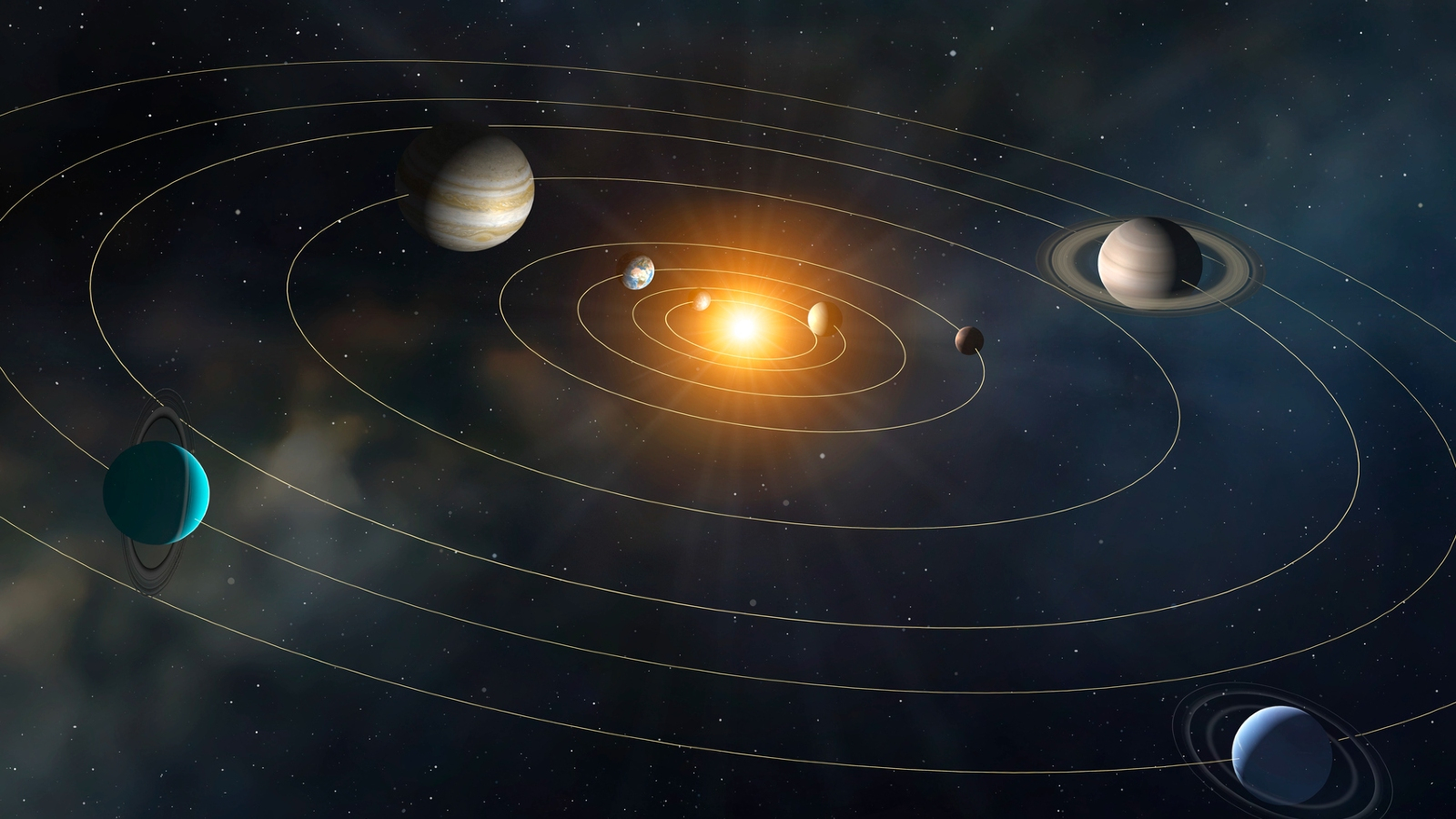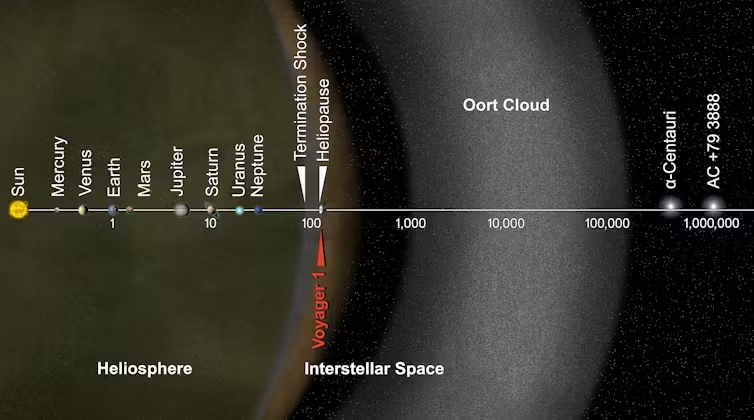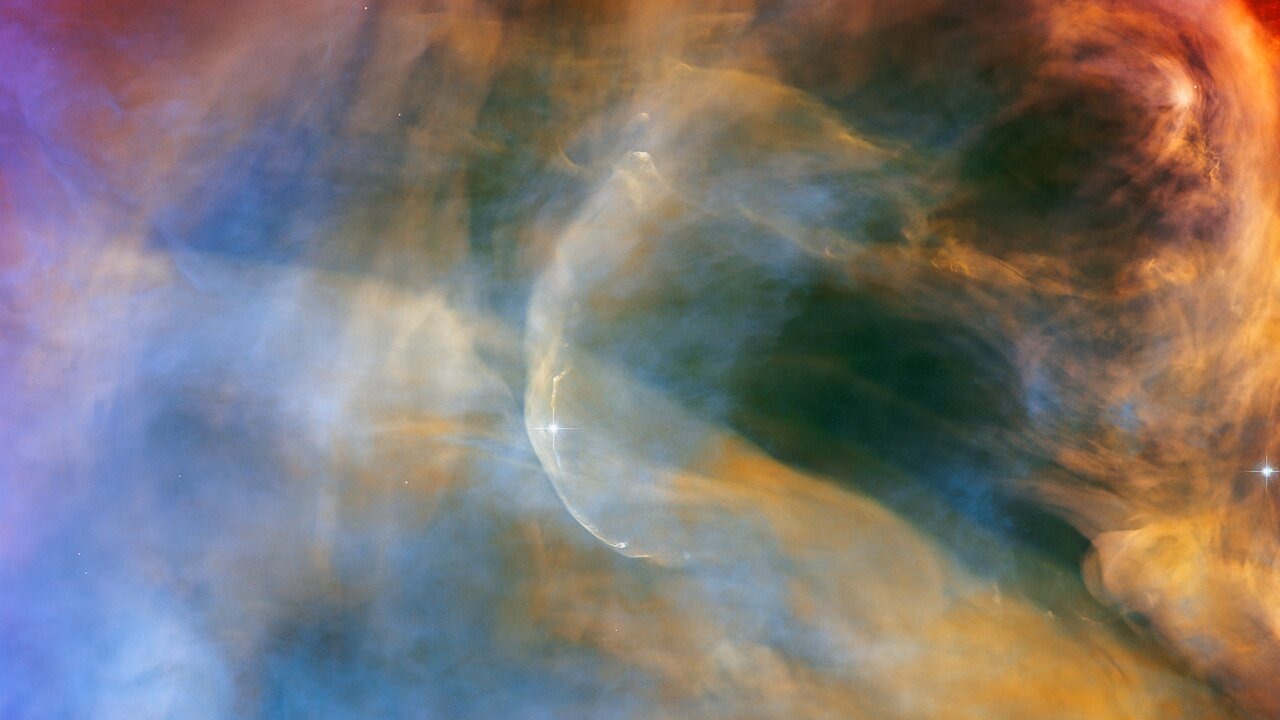
How astronomers work out the size of our solar system
June 25, 2024 marked a new “first” in the history of spaceflight.

This article was originally published at The Conversation. The publication contributed the article to Space.com's Expert Voices: Op-Ed & Insights.
The size of the solar system is defined by the volume of space over which the sun’s influence exceeds those of other nearby stars in the Milky Way galaxy. This influence derives from two fundamental forces of nature: gravity and magnetism.
Let’s tackle gravity first. Every object in the solar system experiences a gravitational pull from the Sun; the farther away one is from the sun, the weaker the pull. Provided, however, that the sun’s gravity is still stronger at your position in space than the gravity from any other stars, then your motion through space will be subject to an acceleration which pulls you towards the sun.
At this point, it is useful to introduce a more convenient unit of measurement for distance: the astronomical unit (AU). A distance of 1 AU is the distance between the Sun and Earth, which is approximately 150 million km. All of the known planets, asteroids, and almost all of the known comets are gravitationally bound to the Sun and orbit around it. More distant objects experiencing a weaker gravitational pull, take longer to complete an orbit.
The Earth, at 1 AU of course, takes one year. Jupiter, orbiting the sun at 5 AU, takes just under 12 years. Distant Pluto (about 40 AU) takes 248 years –- so long in fact, that it hasn’t even completed one orbit of the sun since it was discovered in 1930. Pluto, however, is far from being at the edge of the solar system; there are many more distant worlds.
Related: Solar system planets, order and formation: A guide

The most distant gravitationally bound objects to the sun are aperiodic comets. Aperiodic, or long-period comets, can take many thousands of years to complete one solar orbit. All of them have completed no more than a single passage through the inner solar system during recorded history.
Get the Space.com Newsletter
Breaking space news, the latest updates on rocket launches, skywatching events and more!
These comets are believed to come from the Oort Cloud; a roughly spherical cloud made up of billions of small icy worlds. These drift through the frigid outermost reaches of the solar system at distances of up to 200,000 AU (approximately 3 Light Years).
An Oort Cloud object may take millions of years to orbit the sun once at such vast distances. Objects which stray farther from the sun than this are likely to experience stronger gravitational pulls from other stars, and begin to accelerate towards those instead.
Oort Cloud objects are so far away that none has been seen in situ by even our most powerful telescopes. The only time we get to see them is when one happens to fall towards the inner solar system, as a comet.
We’ve heard about gravity, but what about that other force: magnetism? In addition to a powerful gravitational field, the sun possesses a very strong magnetic field, which carves out a volume of space called the heliosphere, within which lie all the planets and the extended atmosphere of the sun, called the solar wind. The solar wind is a continuous supersonic outflow of plasma from the Sun into interplanetary space.
Solar wind
The solar wind is highly dynamic and when interacting with the atmosphere of a planet like the Earth it can generate colorful displays of aurora such as those we saw recently. The solar wind flows outwards from the sun, past all the known planets, before finally slowing down and becoming subsonic (slower than the speed of sound) when it reaches the heliopause.
The distance to the heliopause is much closer to the Sun than the Oort Cloud. Nevertheless, it is still enormous. Having launched in 1977 the NASA spacecraft Voyager 1 crossed the heliopause, at a distance of 121 AU, in 2012, becoming the first human built object to reach interstellar space.
Had Voyager 1 been launched by our evolutionary ancestors a few million years ago, however, the journey to the heliopause might not have taken quite so long. The space between the stars is not empty, but is filled with tenuous clouds of gas and dust called the interstellar medium. Sometimes, the orbit of a star around the center of the Milky Way galaxy may carry it through unusually dense regions of material.

In a recent study, scientists have demonstrated a high likelihood that about 2-3 million years ago, the solar system passed through a relatively dense cloud of cold interstellar gas which could have compressed the heliosphere down to a size of just 0.2 AU which is entirely within the orbit of Mercury - the nearest planet to the Sun and, arguably, the Earth. This would have directly exposed all of the planets to the environment of interstellar space.
Among the potential impacts on Earth were a substantial increase in cosmic rays reaching our planet, no aurora (because the solar wind could not reach the Earth), and a more changeable climate which may even have influenced the evolution of our species.
Join our Space Forums to keep talking space on the latest missions, night sky and more! And if you have a news tip, correction or comment, let us know at: community@space.com.

Gareth Dorrian completed a PhD in Solar Terrestrial Physics (2009) and is now a Post-Doctoral Research Fellow at the University of Birmingham. As part of the Space Environment and Radio Engineering (SERENE) group, Gareth is working with the Low-Frequency Array (LOFAR) to investigate small scale ionospheric structures. His interests include geomagnetism, solar physics, and the space weather environment.









